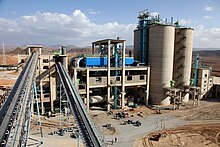Untitled 1
Apparently unaware of Smeaton’s work, the same principle was identified by Frenchman Louis Vicat in the first decade of the nineteenth century. Vicat went on to devise a method of combining chalk and clay into an intimate mixture, and, burning this, produced an “artificial cement” in 1817[14] considered the “principal forerunner”[3] of Portland cement and “…Edgar Dobbs of Southwark patented a cement of this kind in 1811.”[3]
In Russia, Egor Cheliev created a new binder by mixing lime and clay. His results were published in 1822 in his book A Treatise on the Art to Prepare a Good Mortar published in St. Petersburg. A few years later in 1825, he published another book, which described the various methods of making cement and concrete, as well as the benefits of cement in the construction of buildings and embankments.[15][16]
Setting time and “early strength” are important characteristics of cements. Hydraulic limes, “natural” cements, and “artificial” cements all rely upon their belite content for strength development. Belite develops strength slowly. Because they were burned at temperatures below 1,250 °C (2,280 °F), they contained no alite, which is responsible for early strength in modern cements. The first cement to consistently contain alite was made by William Aspdin in the early 1840s: This was what we call today “modern” Portland cement. Because of the air of mystery with which William Aspdin surrounded his product, others (e.g., Vicat and Johnson) have claimed precedence in this invention, but recent analysis[20] of both his concrete and raw cement have shown that William Aspdin’s product made at Northfleet, Kent was a true alite-based cement. However, Aspdin’s methods were “rule-of-thumb”: Vicat is responsible for establishing the chemical basis of these cements, and Johnson established the importance of sintering the mix in the kiln.
In the US the first large-scale use of cement was Rosendale cement, a natural cement mined from a massive deposit of a large dolostone rock deposit discovered in the early 19th century near Rosendale, New York. Rosendale cement was extremely popular for the foundation of buildings (e.g., Statue of Liberty, Capitol Building, Brooklyn Bridge) and lining water pipes.[21]
Sorel cement was patented in 1867 by Frenchman Stanislas Sorel and was stronger than Portland cement but its poor water resistance and corrosive qualities limited its use in building construction. The next development with the manufacture of Portland cement was the introduction of the rotary kiln which allowed a stronger, more homogeneous mixture and a continuous manufacturing process.[3]
20th century[edit]
Calcium aluminate cements were patented in 1908 in France by Jules Bied for better resistance to sulfates.[22]
In the US, the long curing time of at least a month for Rosendale cement made it unpopular after World War One in the construction of highways and bridges and many states and construction firms turned to the use of Portland cement. Because of the switch to Portland cement, by the end of the 1920s of the 15 Rosendale cement companies, only one had survived. But in the early 1930s it was discovered that, while Portland cement had a faster setting time it was not as durable, especially for highways, to the point that some states stopped building highways and roads with cement. Bertrain H. Wait, an engineer whose company had worked on the construction of the New York City’s Catskill Aqueduct, was impressed with the durability of Rosendale cement, and came up with a blend of both Rosendale and synthetic cements which had the good attributes of both: it was highly durable and had a much faster setting time. Wait convinced the New York Commissioner of Highways to construct an experimental section of highway near New Paltz, New York, using one sack of Rosendale to six sacks of synthetic cement. It was proved a success and for decades the Rosendale-synthetic cement blend became common use in highway and bridge construction.[21]

